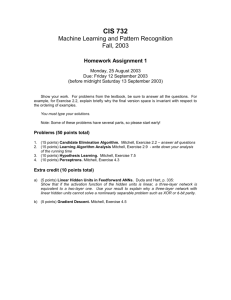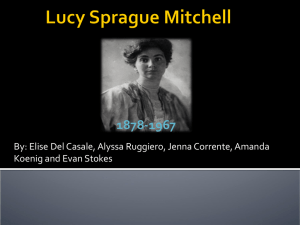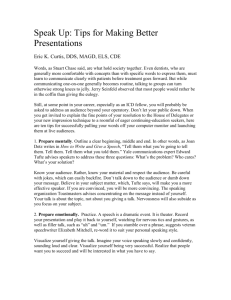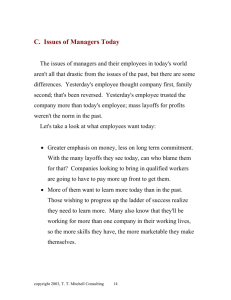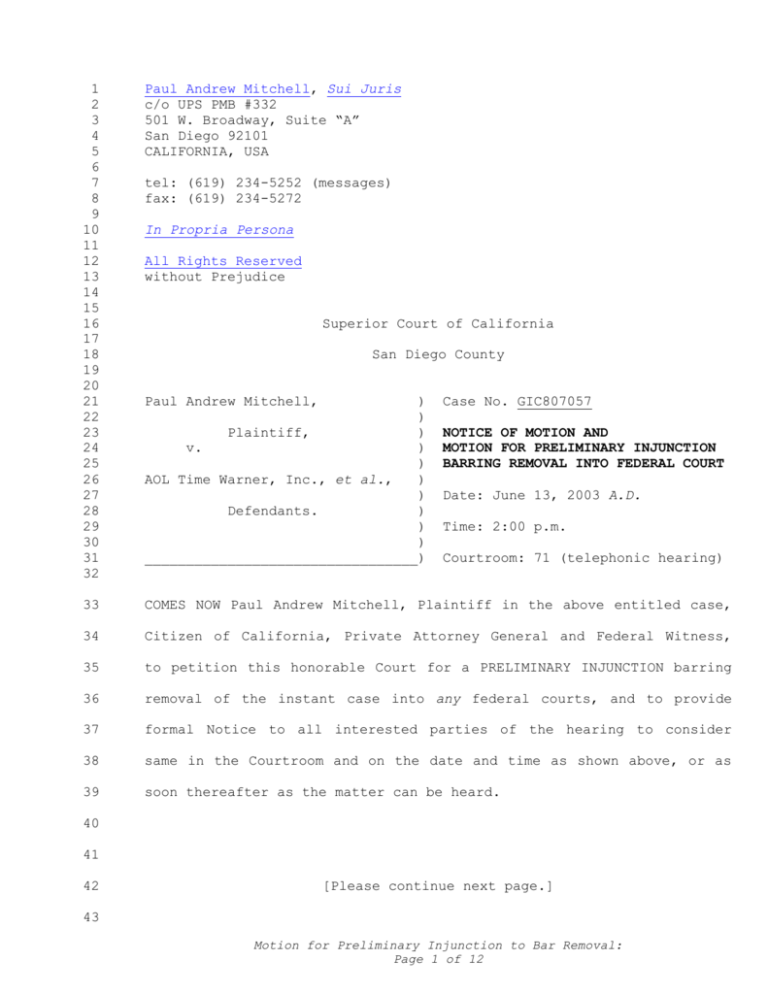
1
2
3
4
5
6
7
8
9
10
11
12
13
14
15
16
17
18
19
20
21
22
23
24
25
26
27
28
29
30
31
32
Paul Andrew Mitchell, Sui Juris
c/o UPS PMB #332
501 W. Broadway, Suite “A”
San Diego 92101
CALIFORNIA, USA
33
COMES NOW Paul Andrew Mitchell, Plaintiff in the above entitled case,
34
Citizen of California, Private Attorney General and Federal Witness,
35
to petition this honorable Court for a PRELIMINARY INJUNCTION barring
36
removal of the instant case into any federal courts, and to provide
37
formal Notice to all interested parties of the hearing to consider
38
same in the Courtroom and on the date and time as shown above, or as
39
soon thereafter as the matter can be heard.
tel: (619) 234-5252 (messages)
fax: (619) 234-5272
In Propria Persona
All Rights Reserved
without Prejudice
Superior Court of California
San Diego County
Paul Andrew Mitchell,
)
)
Plaintiff,
)
v.
)
)
AOL Time Warner, Inc., et al.,
)
)
Defendants.
)
)
)
_________________________________)
Case No. GIC807057
NOTICE OF MOTION AND
MOTION FOR PRELIMINARY INJUNCTION
BARRING REMOVAL INTO FEDERAL COURT
Date: June 13, 2003 A.D.
Time: 2:00 p.m.
Courtroom: 71 (telephonic hearing)
40
41
42
[Please continue next page.]
43
Motion for Preliminary Injunction to Bar Removal:
Page 1 of 12
1
2
INCORPORATION OF SUPPLEMENTS
Concurrently
herewith,
Plaintiff
files
and
incorporates
by
3
reference the following seven (7) SUPPLEMENT’s to the instant MOTION,
4
with their corresponding URL’s where electronic copies of these same
5
pleadings can be easily viewed on the Internet, to wit:
6
7
8
9
10
11
12
13
14
15
16
17
18
19
20
21
22
23
24
25
26
27
28
29
30
31
32
33
34
35
36
37
38
39
40
41
42
43
44
45
46
#
---
Description
----------------------------------------------------------
(1)
OPENING BRIEF in USA v. Gilbertson, Eighth Circuit (1997):
http://www.supremelaw.org/cc/gilberts/opening.htm
(filed concurrently herewith)
(2)
OPENING BRIEF in Mitchell v. AOL Time Warner, Inc. et al.,
Ninth Circuit (2002):
http://www.supremelaw.org/cc/aol/opening.htm
(already filed as Exhibit N-86)
(3)
Appellant’s REPLY to AOL Time Warner, Inc.
Individual AOL Defendants, in Mitchell supra:
and
to
the
University,
in
http://www.supremelaw.org/cc/aol/reply.htm
(already filed as Exhibit N-108)
(4)
Appellant’s REPLY
Mitchell supra:
to
Carnegie
Mellon
http://www.supremelaw.org/cc/aol/reply.cmu.htm
(already filed as Exhibit N-109)
(5)
Appellant’s REPLY to the University Defendants in Mitchell
supra:
http://www.supremelaw.org/cc/aol/reply.univ.htm
(already filed as Exhibit N-112)
(6)
PETITION FOR REHEARING EN BANC in Mitchell supra:
http://www.supremelaw.org/cc/aol/enbanc.htm
(already filed as Exhibit N-126)
(7)
APPLICATION FOR WRIT OF QUO WARRANTO in Mitchell supra:
http://www.supremelaw.org/cc/aol/quowarranto.htm
(already filed as Exhibit N-127)
47
Motion for Preliminary Injunction to Bar Removal:
Page 2 of 12
1
This honorable Superior Court is strongly encouraged to take full
2
advantage of the speed and accessibility provided by all Internet
3
copies of the above pleadings and working hyperlinks, particularly
4
using a broadband connection to the Internet, e.g. DSL or cable modem.
5
6
SUMMARY OF PERTINENT HISTORY
7
In 1996 A.D., Plaintiff Paul Andrew Mitchell (“Mitchell”) was
8
authorized by the United States District Court in Tucson, Arizona, to
9
defend a trust against a SUBPOENA allegedly served upon it by a panel
10
of federal citizens claiming to exercise the powers of a lawfully
11
convened federal grand jury.
See 28 U.S.C. 1861 et seq.
12
To challenge many of that panel’s legal presumptions, Mitchell
13
submitted requests under the federal Freedom of Information Act for
14
the credentials of certain agents and employees of the “United States”
15
(federal government) who had touched that case in various ways.
16
After Mitchell submitted a proper and timely FOIA appeal for
17
those credentials, presiding U.S. District Judge John M. Roll ruled
18
that the USDC was not the proper forum to bring a request under the
19
Freedom of Information Act (“FOIA”).
20
Because
this
ruling
had
conflict
already
been
with
the
identified
court
in
of
original
22
Citizen’s Guide to the FOIA and Privacy Act, as published by the
23
Government Printing Office in Washington, D.C., Mitchell submitted a
24
formal request that Judge Roll clarify that particular ruling.
25
Judge Roll never responded to that request for clarification.
27
which
to
21
26
jurisdiction
appeared
See 5 U.S.C. 552(a)(4)(B).
the
But,
This sparked Mitchell’s intellectual curiosity to such an extent,
it remains as strong today as it was when it began in 1996.
Motion for Preliminary Injunction to Bar Removal:
Page 3 of 12
1
What followed from that one, relatively isolated and seemingly
2
insignificant ruling has grown into a major research project, and an
3
equally significant series of court cases, which now clearly reveal
4
that
5
federal district courts in the American court system.
6
there
The
are
two
first
(2)
class
entirely
of
separate
federal
and
distinct
district
courts
classes
are
of
called
7
constitutional courts, because they originate in Article III of the
8
U.S. Constitution.
9
The
second
class
of
territorial
federal
courts,
district
because
courts
they
are
originate
called
10
legislative,
11
Territory Clause at Article IV, Section 3, Clause 2, in the U.S.
12
Constitution.
13
or
See the Arising Under Clause, for example.
in
the
Here, Congress has municipal legislative jurisdiction.
Plaintiff herein argues, and formally offers to prove, that all
14
constitutional
district
courts
are
currently
vacant,
and
all
15
legislative district courts are currently structured to guarantee bias
16
and prejudice against Citizens of California who freely decline to
17
subject themselves to the municipal jurisdiction of the United States.
18
19
THE LANHAM ACT AND THE CASE AGAINST AOL et al.
20
Building on many years of research and litigation, Mitchell filed
21
a
landmark
22
constitutional
23
California, on August 1, 2001 A.D. (hereinafter “DCUS”).
24
copyright
District
and
trademark
Court
of
the
infringement
United
States
suit
in
in
the
Sacramento,
Exhibit N-1.
Count Two is a rather pivotal point in his Initial COMPLAINT in
25
that
case,
because
it
alleges
violations
of
a
relatively
unknown
26
federal trademark law known as the Lanham Act.
27
uncodified in Title 15 of the United States Code, requiring Citizens
This Act is presently
Motion for Preliminary Injunction to Bar Removal:
Page 4 of 12
1
to revert to the original Statutes at Large to identify the specific
2
federal court(s) upon which Congress conferred original jurisdiction.
3
The statute in question is found at 60 Stat. 440, first enacted
4
in
July
of
1946
A.D.
It
conferred
5
Article III DCUS inside the Union.
original
jurisdiction
on
the
6
The legislative United States District Court, on the other hand,
7
was effectively “broadcasted” into the several States of the Union on
8
June 25, 1948 A.D.
9
District
Courts
Prior to that important date, the United States
(“USDC”)
had
only
been
authorized
by
Congress
to
10
convene inside the federal Territories and the District of Columbia,
11
where Congress enjoys exclusive legislative jurisdiction.
12
Moreover, the Act of June 25, 1948, particularly the codified
13
statute at 28 U.S.C. 132, never expressly abolished the Article III
14
DCUS previously convened inside the several States of the Union.
15
Thus,
even
if
Congress
had
fully
intended
to
re-define
the
16
statutory meaning of the term “district court of the United States”,
17
such a re-definition could never have had any retroactive effects,
18
because retroactive legislation is expressly prohibited by the ex post
19
facto Clause, even in civil matters.
20
“district courts”, see U.S. v. King, 119 F.Supp. 398, hn. 8 (1954).
On the meaning of the term
21
Making matters worse, in the Act of June 25, 1948 -- at 28 U.S.C.
22
2072 -- Congress attempted in vain to authorize the U.S. Supreme Court
23
to
24
abrogate any federal statutes that predate those rules.
25
is known as the Rules Enabling Act, and the offensive section found at
26
28 U.S.C. 2072(b) is called the Abrogation Clause, also known as the
27
Supersession Clause (hereinafter “Abrogation Clause”).
issue
rules
of
evidence
and
procedure
which
may
Motion for Preliminary Injunction to Bar Removal:
Page 5 of 12
override
or
This statute
1
Not
only
does
the
Abrogation
Clause
violate
the
prohibition
2
against ex post facto legislation;
it also violates the Separation of
3
Powers Doctrine -- by attempting to delegate legislative powers to the
4
U.S. Supreme Court, contrary to Article I, Section 1.
5
The constitutionality of the Rules Enabling Act, and of the Act
6
of June 25, 1948 in toto, are both properly challenged in Mitchell’s
7
federal case against AOL Time Warner, Inc. et al.
8
Exhibits N-19 and N-78, sec. 7(e) in Exhibit N-86, and Exhibit N-94.
In particular, see
9
10
TERRITORIES AND THE U.S. CONSTITUTION
11
The last important pieces of this complex puzzle are a pair of
12
federal statutes which expressly extended the U.S. Constitution into
13
the District of Columbia in 1871 A.D., and then into all federal
14
Territories in 1873 A.D. (hereinafter called “extension statutes”).
15
The extension statutes are immensely important, in light of a
16
specious
court
doctrine
which
grew
out
of
the
case
of
Downes
v.
17
Bidwell, 182 U.S. 244 (1901).
18
that case held that the Constitution of the United States, as such,
19
did not extend beyond the limits of the States united by and under it.
Summarizing briefly, the high Court in
20
Later, in Hooven & Allison v. Evatt, 324 U.S. 652 (1945) the high
21
Court elaborated this specious doctrine by ruling that the guaranties
22
[sic] of the U.S. Constitution extend into the insular Possessions
23
only as Congress makes those guaranties applicable -- by enacting
24
federal legislation to that end.
25
However, both cases clearly overlooked the extension statutes,
26
which prove that the Downes Doctrine was ultra vires thirty years
27
before the fact.
What a colossal oversight by the Supreme Court!
Motion for Preliminary Injunction to Bar Removal:
Page 6 of 12
1
In the present context, the extension statutes also prove that
2
the several States of the Union may not legally be treated as federal
3
Territories by statute, by treaty, or in any manner whatsoever.
4
5
IMPLICATIONS FOR FEDERAL ADJUDICATION
6
Without oversimplifying the important conclusions to be drawn
7
from the many cases which have confronted these monumentally important
8
issues, Plaintiff submits that federal legislative courts have simply
9
assumed the power to enforce, or withhold, the guarantees of the U.S.
10
11
Constitution as their extensive legislative “discretion” deems fit.
An excellent analog can be seen by comparing Rules 201(c) and
12
201(d)
13
discretionary
14
mandatory judicial notice to be taken of adjudicative facts.
15
16
of
the
Federal
judicial
Plaintiff
argues
Rules
of
notice,
that
Evidence.
Rule
whereas
discretionary
Rule
notice
201(c)
authorizes
201(d)
is
authorizes
to
legislative
courts, as mandatory notice is to constitutional courts.
17
In
the
latter
18
Constitution
19
comparison,
20
Congress appears to have delegated entirely to the arbitrary and often
21
capricious whims of politically motivated federal appointees.
is
a
courts,
judicial
enforcing
any
enforcing
all
imperative;
of
those
in
guarantees
the
guarantees
of
former
is
a
the
U.S.
courts,
matter
by
that
22
The arbitrary and capricious decisions that are routinely issued
23
by federal judges, now presiding on the United States District Courts
24
inside the several States, are manifestations of bias and prejudice
25
that are not only prohibited by federal law, but are also ever present
26
whenever proper challenges are mounted to federal tax or monetary
27
policies and practices.
See 28 U.S.C. 455, in chief.
Motion for Preliminary Injunction to Bar Removal:
Page 7 of 12
1
Thus,
despite
a
mountain
of
well
pleaded
and
meticulously
2
detailed arguments in Gilbertson’s OPENING BRIEF, including a seminal
3
analysis of all federal removal statutes at Topic “E”, the Eighth
4
Circuit in that case issued an UNPUBLISHED summary ruling, holding
5
that the Internal Revenue Code is not vague.
6
that same Court ruled that UNPUBLISHED opinions are unconstitutional:
7
Then, three years later,
http://www.supremelaw.org/decs/anastasoff/99-3917EM.pdf
8
And, despite timely and earnest attempts to preserve that body of
9
work and to intervene in that appeal by the People of the United
10
States of America ex rel. Paul Andrew Mitchell, the Eighth Circuit to
11
this day refuses to rule on Their application for intervention.
12
For cases supporting the proposition that legislative courts are
13
not
required
14
constitutional courts, see the following:
15
Benner
16
Englebrecht, 80 U.S. 434, 447 (1871);
17
648, 655 (1873);
18
U.S., 98 U.S. 145, 154 (1878);
19
(1879);
20
Federal Trade Commission v. Klesner, 274 U.S. 145 (1927);
21
United States, 276 U.S. 311 (1928);
22
279 U.S. 438 (1929);
23
281 U.S. 464 (1930);
24
285
25
(1933);
26
Pipeline Co. v. Marathon Pipe Line Co., 458 U.S. 50 (1982).
v.
U.S.
to
exercise
Porter,
50
the
U.S.
Article
235,
III
guarantees
required
of
American Insurance supra;
242-243
(1850);
Clinton
v.
Hornbuckle v. Toombs, 85 U.S.
Good v. Martin, 95 U.S. 90, 98 (1877);
Reynolds v.
The City of Panama, 101 U.S. 453, 460
Keller v. Potomac Electric Power Co., 261 U.S. 428 (1923);
382
(1932);
Swift v.
Ex parte Bakelite Corporation,
Federal Radio Commission v. General Electric,
Claiborne-Annapolis Ferry Co. v. United States,
O’Donoghue
v.
United
States,
289
Glidden Co. v. Zdanok, 370 U.S. 530 (1962);
27
Motion for Preliminary Injunction to Bar Removal:
Page 8 of 12
U.S.
516
and Northern
1
CONCLUSIONS
2
By
carefully
considering
the
essential
highlights
discussed
3
above, and by reviewing all incorporated SUPPLEMENT’s with equal care
4
and attention to all pertinent details, Plaintiff is confident that
5
the official record now before this Superior Court of California more
6
than
7
vacant, even though it still exists inside the 50 States of the Union.
8
9
conclusively
proves
that
the
Article
III
DCUS
is
presently
All U.S. District Judges have been commissioned to preside on the
legislative USDC now extant inside those 50 States.
10
And, the official record here also proves conclusively that all
11
U.S. District Judges commissioned to preside upon the Article IV USDC
12
are
13
monetary reform, that they are effectively disqualified by virtue of
14
the prohibitions expressly itemized at 28 U.S.C. 455.
so
demonstrably
biased
and
prejudiced
in
matters
of
tax
and
15
This is particularly so in the instant case, because all federal
16
judges fall, as a group, into a class of people all of whom are
17
material
18
Exemption Certificate (“WEC”) from them, when they were first hired as
19
“employees” of the federal judiciary.
20
Internal Revenue Code, in chief, also known as 26 U.S.C. 3402(n):
21
22
witnesses
to
the
practice
of
concealing
the
Withholding
See section 3402(n) of the
http://www.law.cornell.edu/uscode/26/3402.html (n)
Contrary to this questionable and provably fraudulent practice,
23
federal
judges
are
decidedly
immune
from
taxes
on
their
judicial
24
compensation by virtue of the clear and fundamental mandate found at
25
Article III, Section 1, in the U.S. Constitution, also known as the
26
Compensation Clause.
27
all federal judges are currently paying taxes on their salaries.
According to Chief Justice William H. Rehnquist,
Motion for Preliminary Injunction to Bar Removal:
Page 9 of 12
1
But, their immunity from taxes on their salaries was upheld in a
2
most erudite decision by the U.S. Supreme Court in Evans v. Gore, 253
3
U.S. 245 (1920).
4
Then, many decades later, in Lord v. Kelley, 240 F.Supp. 167, 169
5
(1965), that district judge admitted that he was ruling for the IRS,
6
because to rule against them would surely guarantee IRS retaliation.
7
The latter holding proves that federal judges are currently subject to
8
undue influence, thus violating federal litigants’ fundamental Right
9
to judges who are competent, independent and impartial.
10
On this latter point, compare Article 14, Section 1, in the
11
International Covenant on Civil and Political Rights, rendered supreme
12
Law by the Supremacy Clause in the U.S. Constitution.
13
14
REMEDY REQUESTED
15
All premises having been duly considered, therefore, Plaintiff
16
respectfully requests this honorable Superior Court of California to
17
issue a timely and lawful ORDER, to remain in force during pendency of
18
this action, enjoining its removal into any federal district court(s)
19
of whatever description and preserving to Plaintiff his fundamental
20
Right to appeal this action upwards, as he deems necessary and proper,
21
using civil remedies available to him within the California State
22
court system.
23
Motion for Preliminary Injunction to Bar Removal:
Page 10 of 12
1
VERIFICATION
2
The Undersigned hereby verifies, under penalty of perjury, under
3
the laws of the United States of America, without the “United States”
4
(federal government), that the above statement of facts and laws is
5
true and correct, according to the best of his current information,
6
knowledge and belief, so help me God, pursuant to 28 U.S.C. 1746(1).
7
See Supremacy Clause in the Constitution for the United States of
8
America, as lawfully amended, i.e. Constitution, Laws and Treaties of
9
the United States are all the supreme Law of this Land.
10
11
12
Dated:
April 30, 2003 A.D.
Signed:
/s/ Paul Andrew Mitchell
___________________________________________
Paul Andrew Mitchell, B.A., M.S., Sui Juris
13
14
15
16
17
Printed:
Motion for Preliminary Injunction to Bar Removal:
Page 11 of 12
1
PROOF OF SERVICE
2
Note:
This
MOTION
has
been
filed
in
advance
3
answers to the SUMMONS and Initial COMPLAINT.
of
any
Defendants’
4
As Defendants’ answers are filed and served, Plaintiff hereby
5
agrees to serve each answering Defendant with a true and correct copy
6
of this MOTION and incorporated SUPPLEMENT’s.
7
8
A separate PROOF OF SERVICE for each Defendant served in that
fashion will be filed with the Court at that time.
Motion for Preliminary Injunction to Bar Removal:
Page 12 of 12

